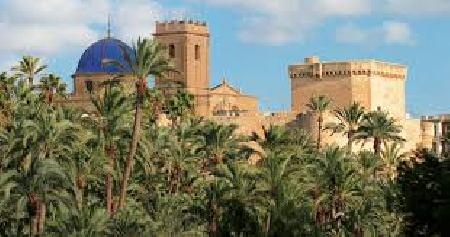Elche
 Elche is a city in the province of Alicante, Spain. Elche is a historical city with an outstanding industry, being footwear its main economic engine. From the visitor's point of view, the city is known for its palm trees: El Palmeral de Elche, with more than 200,000 palm trees, is one of the largest palm groves in the world, and is included in the list of UNESCO heritage sites.
Elche is a city in the province of Alicante, Spain. Elche is a historical city with an outstanding industry, being footwear its main economic engine. From the visitor's point of view, the city is known for its palm trees: El Palmeral de Elche, with more than 200,000 palm trees, is one of the largest palm groves in the world, and is included in the list of UNESCO heritage sites.
Elche has another UNESCO Heritage Site, the Mystery of Elche. It dates from the Middle Ages and is declared one of the Masterpieces of the Oral and Intangible Heritage of Humanity.
In addition to being 20 km from the city center, six beaches on the Costa Blanca belong to Elche, located to the north and south of the neighboring city of Santa Pola.
Elche's history dates back to the 5th century BC, as a native Iberian settlement. The emblematic Lady of Elche (currently housed in the National Archaeological Museum of Madrid) has been dated to the 5th or 4th century BC. When the Romans took the city they called it Ilici, which explains the demonic name that is still used to refer to the inhabitants of the city.
Under the Muslim period, new irrigation systems were introduced that allowed the creation of an oasis in Elche. In honor of the holy city of Medina, founded next to an oasis with palm trees, the city of Elche began its unique palm grove at the end of the 10th century AD. Even being a Muslim symbol, the oasis was respected when the city passed back to Christian hands, due to its economic value.
Basilica of Santa Maria:
With its two blue domes and flamboyant baroque entrance, it is no doubt exceptionally beautiful. It was originally built on the site of a ruined mosque, but the church we see today is mostly Baroque, remodeled in the 17th century. It is known for the play of the Mystery of Elche, which takes place every year in the basilica.
Elche Mystery:
The Mystery of Elche is celebrated every year The Basilica of Santa María de Elche is the only Catholic church in the world that is allowed to perform this special theatrical and musical show, dating from the 15th century. It represents the ascension of the Virgin Mary to heaven, in which the person who plays Mary is lifted through a hole in the ceiling by an original (and carefully maintained) piece of machinery from the 15th century called the Deus ex machina. María is then crowned in an elaborate ceremony accompanied by music and songs in a mixture of Old Valencian and Latin. The tradition is well-liked by the locals. It has also been recognized by UNESCO for its cultural importance.
Elche Archaeological and History Museum:
Discover the history of Elche in an entertaining and interactive exhibition at the Altamira Palace. The restored 12th-century palace, originally built as an aristocratic family home and later used as a prison during the Spanish Civil War, has its own fascinating history. You will also see a large collection of antiques and artifacts spanning the entire history of the city. Do not miss one of the most emblematic places in the city, La Dama de Elche, a statue dating from the 4th century B.C. and that it was discovered here in 1897. Its history and purpose is unknown, although many believe that the figure was part of a funeral urn or a larger monument. The original is kept in a museum in Madrid, but while the people of Elche await her return, there is an exact replica in the Torreón del Museo tower.
Walk through the palm groves:
Elche is world famous for being home to some 200,000 palm trees of many different types, in various parks in and around the city. Follow the Ruta del Palmeral, 2.5 kilometers long, which begins and ends in the Huerto de San Plácido Park, near the Museo del Palmeral. The trail is clearly marked and easy to follow, passing through the most important areas and the most famous trees.
Stroll along the beach:
Elche is only a few kilometers from the coast and there are plenty of great beaches to choose from. One of the most popular is Los Arenales del Sol, located north of the city of Santa Pola, it is a long white sand beach perfect for swimming. To the south, the beaches of El Pinet, La Marina and Les Pesqueres-El Rebollo are also popular.

